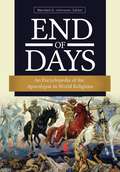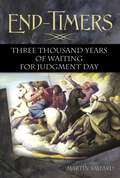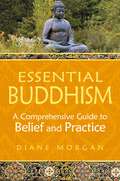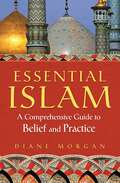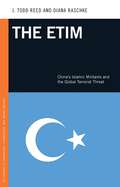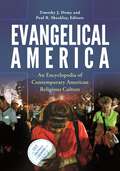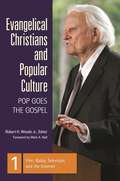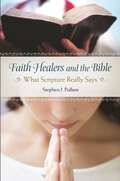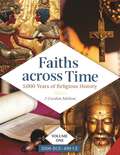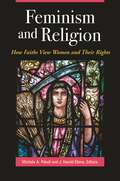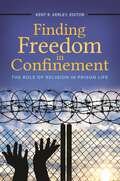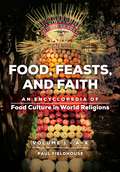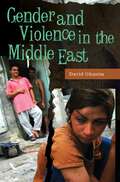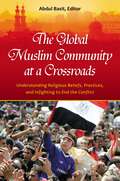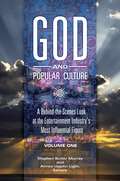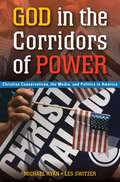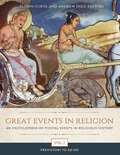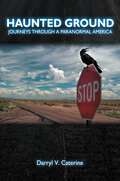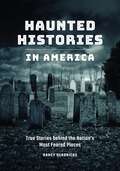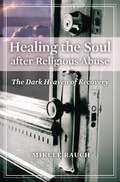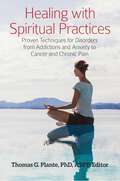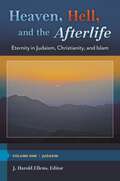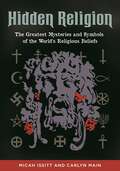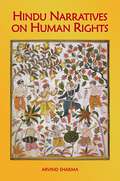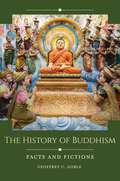- Table View
- List View
End of Days: An Encyclopedia of the Apocalypse in World Religions
by Wendell G. JohnsonCovering religious traditions ranging from Buddhism to Christianity to Zoroastrianism and modern apocalyptic movements such as Arun Shinrikyo and the Branch Davidians, this book addresses prophesied end of days from a breadth of perspectives and includes material on often-neglected themes and genres.End of Days: An Encyclopedia of the Apocalypse in World Religions describes apocalyptic writings in the world's major religious traditions, including Judaism, Christianity, Islam, Hinduism, and Buddhism. The cross-referenced entries address ancient traditions—Zoroastrianism, as one example—as well as modern apocalyptic movements, such as Arun Shinrikyo, the Branch Davidians, and the Order of the Solar Temple.This book's broad scope offers coverage of overlooked traditions, such as Mayan Apocalyptic, Norse Apocalyptic, Native American eschatological literatures, and the Tibetan Book of the Dead. Readers seeking detailed information on the eschatological and apocalyptic movements and proponents of End Times can reference entries about individuals such as Harold Camping, Jerry Falwell, David Koresh of the Brand Davidians, and James Jones and the People's Temple. This single-volume encyclopedia also contains numerous historical entries on subjects such as the Great Disappointment, the Great Awakening periods of religious revival, Joachim of Flora, the Maccabean Revolt, and the Plymouth Brethren. The influence of apocalyptic ideas far outside the realm of religion itself is documented through entries on film, including well-known modern movies such as The Hunger Games and Apocalypse Now, literature by writers such as Dante, and works of fine art like Wagner's Götterdämmerung. The inclusion of entries related to literature, film, and other art forms further attests to the wide-ranging social influence of belief in the end of days.
End-Timers: Three Thousand Years of Waiting for Judgment Day
by Martin BallardThis fascinating history surveys apocalyptic religion through time, setting it within a political and social context.End-Timers: Three Thousand Years of Waiting for Judgment Day examines the high and low points of millennial expectation across the centuries. It shows how and why such beliefs first developed in antiquity, and it explores how end-timers influenced events as varied as the persecutions of Hellenistic ruler Antiochus Epiphanes and Roman Emperor Nero, the Crusades, the settlement of North America, and the 20th-century debacles at Jonestown and Waco.Suggesting that anyone who wishes to understand the Middle East today needs to penetrate the background of modern fundamentalism within the three Semitic religions, the author illuminates the part played by Christian Zionists in promoting the return of the Jews to the "promised land" and the resulting formation of the state of Israel, as well as subsequent fundamentalist reactions within both Judaism and Islam. He also follows the birth of the "Christian Right" in 19th-century Britain and its development and growing influence in the United States. Finally, the book examines how religious end-timers confront the four horsemen of the 21st-century apocalypse: world population increase, depletion of natural resources, advanced weaponry, and global warming.
Essential Buddhism: A Comprehensive Guide to Belief and Practice
by Diane MorganAn engaging, clear-sighted book that covers all aspects of this rich, peaceful, and insightful tradition.Author Diane Morgan brings her compelling writing style and deep understanding to Essential Buddhism: A Comprehensive Guide to Belief and Practice. This lively book presents a clear, thorough, and objective introduction to the many facets of Buddhist philosophy and faith, including basic beliefs, major texts, practices, and important figures of each branch of the tradition. The book devotes an entire chapter of the remarkable life of the Buddha, from his amazing conception to his future appearance. It discusses the sophisticated way in which Buddhism intertwines its complex metaphysics and practical ethics through the Four Noble Truths, the Eightfold Noble Path, and the doctrine of Dependent Arising, and also devotes detailed attention to such Buddhist basics as the Wheel of Becoming, the mysterious world of Tantra, and the riddles of Zen. Complete with stories, koans, and biography, the book will help readers see how each tradition developed within the larger context of the faith, even as they explore Buddhism's remarkable facility for liberating the mind.
Essential Islam: A Comprehensive Guide to Belief and Practice (Non-ser.)
by Diane MorganAn introductory guide to the important elements of the world's largest religion, including the Quran, the Pillars of Faith, and the life of Muhammad, as well as Islamic history, customs and rituals, and contributions to world culture.Essential Islam: A Comprehensive Guide to Belief and Practice is the ideal beginner's resource on the core elements of a faith that, like Christianity and Judaism, offers a guide to holy living and a path to salvation—one that like other world faiths has inspired peace and war, tolerance and brutality, enlightenment and abysmal ignorance.Essential Islam offers an insightful, objective look at Islam from its inception to the present day, including a discussion of Islamic beliefs about God, history, warfare, marriage, the afterlife, and the relationship between Islam and other faiths. It is a rich source for dispelling misconceptions—for example, only 10 percent of Muslims are Arabic, and only a quarter of those reside in the Middle East—and for understanding tensions between groups within and outside Islam. More importantly, it gives readers a portrait of Islam not as a religion of extremists, but as a dynamic living faith practiced by people of all kinds in virtually every corner of the world.
The ETIM: China's Islamic Militants and the Global Terrorist Threat (PSI Guides to Terrorists, Insurgents, and Armed Groups)
by J. Todd Reed Diana RaschkeThis comprehensive account examines the East Turkistan Islamic Movement (ETIM)—the most significant Muslim militant group in China—including its origins, objectives, ideology, leadership, and tactics.To effectively engage China on counterterrorism issues, we must understand the capabilities and intentions of the East Turkistan Islamic Movement (ETIM), the most significant Muslim militant group in China. The ETIM: China's Islamic Militants and the Global Terrorist Threat is the first book to focus specifically on the ETIM, a terrorist group that demands an independent Muslim state for the Uyghur ethnic minority in northwest China. This fascinating study offers a comprehensive account of the group's origins, objectives, ideology, leadership, and tactics. It details the historical and contemporary contexts of the Uyghur separatist movement, the ETIM's alleged ties to international terrorist networks, and the Chinese government's interest in promoting the ETIM as a significant international problem. In addition, the book addresses conflicting claims about the membership and viability of the organization, noting where the Chinese government has apparently manipulated information about the ETIM to suit its own goals. A final chapter explores how various countries define ETIM activities and what that means for relations with China.
Evangelical America: An Encyclopedia of Contemporary American Religious Culture
by Timothy J. Demy and Paul R. Shockley, EditorsAn essential new reference work for students and general readers interested in the history, dynamics, and influence of evangelicalism in recent American history, politics, and culture.What makes evangelical or "born-again" Christians different from those who identify themselves more simply as "Christian"? What percentage of Americans believe in the Rapture? How are evangelicalism and Baptism similar? What is the influence of evangelical religions on U.S. politics? Readers of Evangelical America: An Encyclopedia of Contemporary American Religious Culture will learn the answers to these questions and many more through this single-volume work's coverage of the many dimensions of and diversity within evangelicalism and through its documentation of the specific contributions evangelicals have made in American society and culture. It also illustrates the Evangelical movement's influence internationally in key issues such as human rights, environmentalism, and gender and sexuality.
Evangelical Christians and Popular Culture [3 volumes]: Pop Goes the Gospel [3 volumes]
by Robert H. WoodsThis three-volume collection demonstrates the depth and breadth of evangelical Christians' consumption, critique, and creation of popular culture, and how evangelical Christians are both influenced by—and influence—mainstream popular culture, covering comic books to movies to social media.Evangelical Christians and Popular Culture: Pop Goes the Gospel addresses the full spectrum of evangelical media and popular culture offerings, even delving into lesser-known forms of evangelical popular culture such as comic books, video games, and theme parks. The chapters in this 3-volume work are written by over 50 authors who specialize in fields as diverse as history, theology, music, psychology, journalism, film and television studies, advertising, and public relations. Volume 1 examines film, radio and television, and the Internet; Volume 2 covers literature, music, popular art, and merchandise; and Volume 3 discusses public figures, popular press, places, and events.The work is intended for a scholarly audience but presents material in a student-friendly, accessible manner. Evangelical insiders will receive a fresh look at the wide variety of evangelical popular culture offerings, many of which will be unknown, while non-evangelical readers will benefit from a comprehensive introduction to the subject matter.
Faith Healers and the Bible: What Scripture Really Says
by Stephen J. PullumAn insightful read for anyone who is interested in religion, this book offers fresh, biblical insight into the preaching of faith healing from a Christian perspective.Faith healing has been a popular religious phenomenon in this country for well over a hundred years, gaining thousands of followers and raking in millions of dollars annually. What faith healers teach, however, often goes unchallenged. Faith Healers and the Bible: What Scripture Really Says offers an informed critique of many of the themes found in faith healers' preaching that documents that much of what they teach is not biblically based—contrary to what they would like their listeners to believe.Drawing on a lifetime of study and nearly two decades of teaching a university course titled "The Rhetoric of Faith Healing," Stephen J. Pullum, PhD, provides scriptural insight into the false claims frequently found in the preaching of healing revivalists. After an introductory chapter that explains why faith healers have been so persuasive, the author addresses a breadth of topics, including the miraculous, the providential, demon possession, the call of God, the indwelling of the Holy Spirit, and the health and wealth gospel. Meeting faith healers on their own turf—the Bible—Pullum clearly demonstrates that much of what faith healers preach cannot be scripturally supported.
Faiths across Time [4 volumes]: 5,000 Years of Religious History [4 volumes]
by J. Gordon MeltonThis monumental, four-volume reference overviews significant events and developments in religious history over the course of more than five millennia.Written for high school students, undergraduates, and general readers interested in the history of world religions, this massive reference chronicles developments in religious history from 3500 BCE through the 21st century. The set comprises four volumes, treating the ancient world from 3500 BCE through 499 CE, 500 through 1399, 1400 through 1849, and 1850 through 2009. Each volume includes hundreds of brief entries, arranged chronologically and then further organized by region and religion. The entries provide fundamental information on topics ranging from the neolithic Ggantija temples near Malta through the election of Mary Douglas Glasspool as bishop of the Episcopal Diocese of Los Angeles in 2009. Global in scope and encyclopedic in breadth, this chronology of world religions is an essential purchase for all libraries concerned with the development of human civilization.
Feminism and Religion: How Faiths View Women and Their Rights (Women's Psychology)
by Michele A. Paludi and J. Harold Ellens, EditorsRenowned subject experts Michele A. Paludi and J. Harold Ellens lead readers through a detailed exploration of the feminist methods, issues, and theoretical frameworks that have made women central, not marginal, to religions around the world.At a conference in 2013, Gloria Steinem noted that religion is the "biggest problem" facing feminism today. In this insightful volume, a team of researchers, psychologists, and religious leaders led by editors Michele A. Paludi and J. Harold Ellens supply their expertise and informed opinions to examine the problems, spur understanding, and pose solutions to the conflicts between religion and women's rights, thereby advocating a global interest in justice and love for women. Examples of subjects addressed include the pro-life/pro-choice debate, feminism in new age thought, and the complex intersections of religion and feminism combined with gender, race, and ethnicity.The contributed work in this unique single-volume book enables a better understanding of how various religions view women—both traditionally and in the modern context—and how feminist thinking has changed the roles of women in some world religions. Readers will come away with clear ideas about how religious cultures can honor feminist values, such as family-friendly workplace policies, reproductive justice, and pay equity, and will be prepared to engage in conversation and constructive debate regarding how faith and feminism are interrelated today.
Finding Freedom in Confinement: The Role of Religion in Prison Life
by Kent R. Kerley, EditorWhat is the nature and impact of faith and religion in prison? This book summarizes contemporary and cutting-edge research on religion in correctional contexts, enabling a scientific understanding of how prisoners use faith in their everyday lives.Religion long has been a tool for correctional treatment. In the United States, religion was the primary treatment modality in the first prisons. Only since the 1980s, however, have social scientists begun to study the nature, extent, practice, and impact of faith and faith-based prison programs. Bringing together the knowledge of scholars from around the world, this single-volume book offers readers a science- and research-based understanding of how prisoners use faith in everyday life, examining the role of religion in prison/correctional contexts from a variety of interdisciplinary and international viewpoints.By considering the perspectives of professionals actually working in corrections or prison settings as well as those of scholars studying religion and/or criminal justice, readers of Finding Freedom in Confinement: The Role of Religion in Prison Life can gain insight into the most contemporary research on religion in correctional contexts. The book contains data-driven, conceptual, and policy-oriented essays that cover major religions such as Christianity, Judaism, and Islam within correctional environments. It also addresses subject matter such as the roles of prison chaplains and correctional officers and the relationships between religion and common aspects of prison life, such as drug abuse, gangs, violence, prisoner identity, rights of prisoners, and rehabilitation.
Food, Feasts, and Faith [2 volumes]: An Encyclopedia of Food Culture in World Religions [2 volumes]
by Paul FieldhouseAn indispensable resource for exploring food and faith, this two-volume set offers information on food-related religious beliefs, customs, and practices from around the world.Why do Catholics eat fish on Fridays? Why are there retirement homes for aged cows in India? What culture holds ceremonies to welcome the first salmon? More than five billion people worldwide claim a religious identity that shapes the way they think about themselves, how they act, and what they eat. Food, Feasts, and Faith: An Encyclopedia of Food Culture in World Religions explores how the food we eat every day often serves purposes other than to keep us healthy and stay alive: we eat to express our faith and to adhere to ethnic or cultural traditions that are part of who we are. This book provides readers with an understanding of the rich world of food and faith. It contains more than 200 alphabetically arranged entries that describe the beliefs and customs of well-established major world religions and sects as well as those of smaller faith communities and new religious movements. The entries cover topics such as religious food rules, religious festivals and symbolic foods, and vegetarianism and veganism, as well as general themes such as rites of passage, social justice, hospitality, and compassion.Each entry on religion explains what the religious dietary laws and guidelines are and how these were interpreted and put into practice historically and in modern settings. The coverage also includes important festivals and feast days as well as significant religious figures and organizations. Additionally, some 160 sidebars provide examples and more detailed information as well as fun facts.
Gender and Violence in the Middle East
by David Ghanim Ph.D.Gender and Violence in the Middle East argues that violence is fundamental to the functioning of the patriarchal gender structure that governs daily life in Middle Eastern societies. Ghanim contends that the inherent violence of gender relations in the Middle East feeds the authoritarianism and political violence that plague public life in the region. In this societal sense, men as well as women may be said to be victims of the structural violence inherent in Middle Eastern gender relations. The author shows that the varieties of physical violence against women for which the Middle East is notorious—honor killings, obligatory beatings, female genital mutilation—are merely eruptions of an ethos of psychological violence and the threat of physical violence that pervades gender relations in the Middle East.Ghanim documents and analyzes the complementary roles of both sexes in sustaining the system of violence and oppressive control that regulates gender relations in Middle Eastern societies. He reveals that women are not only victims of violence but welcome the opportunity to become perpetrators of violence in the married female life cycle of subordination followed by domination. The mother-in-law plays a crucial role in supporting the structure of patriarchal control by stoking tensions with her daughter-in-law and provoking her son to commit sanctioned violence on his wife. The author applies his deep analysis of gender and violence in the Middle East to illuminate the motivational profiles of male and female political suicidalists from the Middle East and the martyrological adulation that they are accorded in Middle Eastern societies.
The Global Muslim Community at a Crossroads: Understanding Religious Beliefs, Practices, and Infighting to End the Conflict (Practical and Applied Psychology)
by Abdul Basit Ph.D.Tackling a subject that is as timely as it is complex, this expert work examines the turmoil inside Muslim communities, helping outsiders to understand and insiders to examine ways in which Islam can be reinterpreted for a modern world.The Global Muslim Community at a Crossroads: Understanding Religious Beliefs, Practices, and Infighting to End the Conflict is an illuminating work. Written by an eminent psychologist who was raised as a Muslim in India and now resides in the United States, it examines the core reasons for the current state of affairs in Muslim communities, explaining the psychological underpinnings of Muslim religion and practices and the reasons they can fuel violence. Drawing on the editor's exposure to Eastern and Western cultures and his longstanding interest in the study of comparative world religions, this impartial analysis takes a multidimensional approach to explaining the current plight of Muslim countries. It candidly discusses issues such as the influence of Islamic schools, the negative and positive roles of Ulema (religious scholars), a lack of critical inquiry into religious thought, Sharia, and the status of women in Islam. Finally, there are positive suggestions about a road to recovery, explaining how Muslim communities can address the interlocking problems they face while retaining the positive aspects of their beliefs.
God and Popular Culture [2 volumes]: A Behind-the-Scenes Look at the Entertainment Industry's Most Influential Figure [2 volumes]
by Stephen Butler Murray and Aimée Upjohn LightThis contributed two-volume work tackles a fascinating topic: how and why God plays a central role in the modern world and profoundly influences politics, art, culture, and our moral reflection—even for nonbelievers.God—in the many ways that people around the globe conceptualize Him, Her, or It—is one of the most powerful, divisive, unifying, and creative elements of human culture. The two volumes of God and Popular Culture: A Behind-the-Scenes Look at the Entertainment Industry's Most Influential Figure provide readers with a balanced and accessible analysis of this fascinating topic that allows anyone who appreciates any art, music, television, film, and other forms of entertainment to have a new perspective on a favorite song or movie. Written by a collective of both believers and nonbelievers, the essays enable both nonreligious individuals and those who are spiritually guided to consider how culture approaches and has appropriated God to reveal truths about humanity and society. The book discusses the intersections of God with film, television, sports, politics, commerce, and popular culture, thereby documenting how the ongoing messages and conversations about God that occur among the general population also occur within the context of the entertainment that we as members of society consume—often without our recognition of the discussion.
God in the Corridors of Power: Christian Conservatives, the Media, and Politics in America
by Michael Ryan Les SwitzerGod in the Corridors of Power: Christian Conservatives, the Media, and Politics in America is a comprehensive study of Christian conservative power in America's political culture—how it was achieved, how it is maintained, and where it is going. It came about in part because of an enduring influence in the school room, the seminary and in the pulpit, and in part because conservatives are so skilled at using commercial and non-commercial media, including religious media, to disseminate their views to broader audiences. Though their power has waxed and waned, they continue to be a potent force in public policy today.The authors argue that the astonishing electoral successes of Christian conservatives at all levels of national, state and local government was made possible by linking political, social, media and religious interests with an emerging consensus about what constitutes a conservative mindset in American politics. Christian conservatives unquestionably have been the most significant component in a coalition of religious conservatives, traditionalist conservatives and neoconservatives that has driven the Republican Party now for almost two generations.This multifaceted understanding of Christian conservative activists in religion and politics traces the impact Christian conservatives have had on American Christianity as a whole while also examining the limitations imposed on the Christian conservative agenda by American civil religion, the Constitution and case law. The authors explore women's reproductive rights in the debate over contraception and abortion, and gay civil rights in the debate over gay marriage and family rights. The debate over intelligent design and evolution is examined in the context of the campaign to transform public school education. The run-up to the wars in Afghanistan and Iraq is scrutinized against the background of the declared "war on terrorism."While the conservative religious and secular coalition within the Republican Party began to fragment even before the end of George W. Bush's first term in office, it remained a powerful force in the 2004 and 2008 elections. The book concludes with some thoughts about the impact of Christian conservatives in politics, media and religion in the future.
Great Events in Religion [3 volumes]: An Encyclopedia of Pivotal Events in Religious History [3 volumes]
by Florin Curta and Andrew HoltThis three-volume set presents fundamental information about the most important events in world religious history as well as substantive discussions of their significance and impact.This work offers readers a broad and thorough look at the greatest events in world religious history, covering a wide range of religions, time periods, and areas around the globe. The entries present authoritative information and informed viewpoints written by expert contributors that enable readers to easily learn about the chief events in religious history, help them to better understand the course of world history, and promote a greater respect for culturally diverse religious traditions. The first of the three volumes covers religion from the preliterary world through around AD 600; the second, the post-classical era from 600 to 1450; and the third, the modern era from 1450 to the present. Each volume begins with a substantive introduction that discusses the history of world religions during the period covered by the volume. The chronologically ordered entries overview each event, place it in historical context, and identify the reasons for its enduring significance.
Haunted Ground: Journeys through a Paranormal America
by Darryl V. CaterineThis fascinating and insightful tour through present-day meetings of Spiritualists, UFOlogists, and dowsers illuminates our obsession with the paranormal and challenges the misunderstanding of the paranormal as a marginal or inconsequential feature of America's religious landscape.According to a 2005 Gallup poll, 75 percent of Americans believe in some form of paranormal activity. The United States has had a collective fascination with the paranormal since the mid-1800s, and it remains an integral part of our culture. Haunted Ground: Journeys through a Paranormal America examines three of the most vibrant paranormal gatherings in the United States—Lily Dale, a Spiritualist summer camp; the Roswell UFO Festival; and the American Society of Dowsers' annual convention of "water witches"—to explore and explain the reasons for our obsession with the paranormal.Both academically informed and thoroughly entertaining, this book takes readers on a "road trip" through our nation, guided by professor of American religion Darryl V. Caterine, PhD. The author interprets seemingly unrelated case studies of phantasmagoria collectively as an integral part of the modern discourse about "nature" as ultimate reality. Along the way, Dr. Caterine reveals how Americans' interest in the paranormal is rooted in their anxieties about cultural, political, and economic instability—and in a historic sense of alienation and homelessness.
Haunted Histories in America: True Stories behind the Nation's Most Feared Places
by Nancy HendricksIf you believe in ghosts, you're in good company. Haunted Histories brings America's most ghostly locales to life, illuminating their role in shaping U.S. history and detailing how they became the nation's most feared places.Haunted Histories takes readers on a state-by-state journey across the United States, exploring the nation's most feared places. Along the way, the text introduces readers to new ghostly tales and takes a fresh look at familiar stories and locations, with an eye to history. From well-known spooky spots like Salem, Massachusetts, to such lesser-known ones as the Shanghai Tunnels of Portland, Oregon, where spirits are supposedly trapped, readers will discover not only where America's most haunted places are but also why they are said to be haunted. The ghosts of the doomed Donner Party allow readers to experience the arduous and often deadly journey of America's westward wagon trains, while different kinds of "spirits" haunting old distilleries allow readers to discover how whiskey almost derailed the new American nation before it was born.This book can be studied for academic purposes as a historical reference, used as a source for classroom assignments, or simply read for the pleasure of a great story.
Healing the Soul after Religious Abuse: The Dark Heaven of Recovery (Religion, Health, and Healing)
by Mikele RauchRecent scandals of clergy sexual abuse have brought attention to the victims and their responses to and recovery from their abuse. But few have considered the effect of the abuse on a victim's soul and religious outlook and beliefs. Healing the Soul after Religious Abuse, offers a unique perspective of recovery and restoration of the soul after religious abuse. The author argues that religious abuse often stops not only psychological growth, but also inward development. The effect is not simply emotional, because the devastation reaches to the core of the spirit. Often there is no place for a God of love or a love of what once was divine. Through a series of personal interviews with persons from the five major religions, Rauch considers various ways that religion can do harm.The stories told in this book include the road to restoration in the wake of institutional abuse and how inner experience is sometimes confused with religious training; the sacred task of spiritual leadership and how to restore trust when there has been a violation; an exploration of sacrifice and a clarification of the notion of shame; a look at the impact of religious bigotry in the areas of race, sexuality, and tolerance; an overview of sexuality and the place it holds in both celibate and family life; the pernicious issue of clergy sexual abuse and the signs of spiritual trauma in response to such violation; a roadmap for restoration and a challenge to religious institutions; and, lastly, ways to reclaim the sacred and rewire the spirit. Through interviews, research, and personal stories, the author tells a story of recovery of the most delicate kind, offering pathways through the dark night of religious violation to a restoration of the soul and its immense possibilities.
Healing with Spiritual Practices: Proven Techniques for Disorders from Addictions and Anxiety to Cancer and Chronic Pain
by Thomas G. PlanteThis interdisciplinary study details spiritual approaches including meditation and yoga shown to be helpful in improving physical and psychological well-being.Whether a person suffers from a psychological or physical malady, such as depression, addictions, chronic pain, cancer, or complications from pregnancy, the best practice treatments likely include one common thread: spiritual practice. From meditation and yoga to spiritual surrender and religious rituals, spiritual practices are increasingly being recognized as physically and mentally beneficial for recovering from illness and for retaining optimal health. Healing with Spiritual Practices: Proven Techniques for Disorders from Addictions and Anxiety to Cancer and Chronic Pain, edited by the director of one of the nation's best-known university institutes of spirituality and health, explains current and emerging practices, their benefits, and the growing body of research that proves them effective. Comprising chapters from expert contributors, this book will appeal to students, scholars, and other readers interested in psychology, medicine, nursing, social work, pastoral care, and related disciplines.
Heaven, Hell, and the Afterlife [3 volumes]: Eternity in Judaism, Christianity, and Islam [3 volumes] (Psychology, Religion, and Spirituality)
by J. Harold EllensChristianity, Islam, and Judaism all feature ideas about heaven, hell, and afterlife, and these concepts have evolved over time within these religions. This work supplies a detailed and coherent understanding of the broad scope of spiritual thinking in the last 3,000 years within the Abrahamic traditions. Heaven, Hell, and the Afterlife: Eternity in Judaism, Christianity, and Islam provides an all-encompassing examination of historic and contemporary perspectives on afterlife in Western religions. In these three volumes, Judaic, Christian, and Muslim scholars join forces, providing an unprecedented review of their individual faith's traditions. Every significant issue and major theme is discussed; no controversial topic is avoided. From ancient doctrines to modern-day outlooks of conservatives, progressives, and liberals in all three religions, all are analyzed and presented here.The framework of the volumes underscores how the ethics and concepts of eternity in the Western "action" religions contrast with Eastern religions that tend to be characterized as "passive" or "withdrawal" religions in their ethics and their notions of afterlife as absorption within universal spirit, Nirvana, or nonexistence. This work is well-suited for undergraduate and graduate students, general readers interested in religion, and professional scholars, particularly those in fields corollary to religious study.
Hidden Religion: The Greatest Mysteries and Symbols of the World's Religious Beliefs
by Micah Issitt Carlyn MainCovering secret societies, mysterious ancient traditions, and the often-mistaken history of the world's religious symbols, this book takes readers on a tour through the fascinating world of religious symbolism and reveals the most mysterious and misunderstood facets of religion.Hidden Religion: The Greatest Mysteries and Symbols of the World's Religious Beliefs not only explores the history and origins of widely recognizable symbols, like the Christian cross and the Star of David, but also introduces readers to more obscure symbols from religious traditions around the world—even defunct ones like those of the ancient Aztec and Mayan societies. In addition, the book discusses the "religious secrets" found in the major religions, including secret societies of Christianity, Judaism, Islam, and Buddhism.Containing more than 170 entries, the encyclopedia is organized by religious category, such as Abrahamic, East Asian, and African Diasporic religions, then alphabetically within each category. Each entry is prefaced with a short introduction that explains where and when the religious tradition originated and describes the religion today. This information is followed by an analysis of the historical development and use of symbols along with an explanation of connections between symbols used by different religions, such as shared astrological symbolism in the form of moon, sun, or star motifs.
Hindu Narratives on Human Rights
by Arvind SharmaThis pioneering work examines the existing understanding of Hinduism in relation to human rights discourse.Written by a leading Hindu scholar, Hindu Narratives on Human Rights is organized around specific rights, such as the right to own property, the rights of children, women's rights, and animal rights. Within these categories and in light of the questions they raise, the book provides a guided tour of Hindu narratives on ethics, ranging from the famous religious epics, the Mahabharata and the Ramayana, to various forms of secular literature drawn from almost a thousand years of Indic civilization. The realization that Hindu ethical discourse is narrative rather than propositional is a relatively recent one. Hence, the prevailing tendency in the West has been to overlook it in the context of the discussion of human rights. This book was written to correct that oversight. It shows that the presence of the universal in the particular in Hindu stories is a key to understanding Hindu thinking about human rights—and it indicates ways in which Hindu ethical discourse can interact creatively with modern human rights discourse.
The History of Buddhism: Facts and Fictions (Historical Facts and Fictions)
by Geoffrey C. GobleOne of the world's most popular religions, Buddhism is also one of the most misunderstood. This reference overviews misconceptions related to Buddhism and reveals the truths behind the myths.Buddhism is practiced by millions of adherents around the world. Originating in ancient India, it spread throughout Asia and then to the West, and it exists in multiple traditions. Despite its popularity, it is also the subject of many misconceptions. This book examines those misconceptions along with the historical truths behind the myths.The book begins with an introduction that places Buddhism in its historical and cultural contexts. This is followed by chapters on particular erroneous beliefs related to the religion. Chapters explore whether Buddhism is a singular tradition, if it is a religion or a philosophical system, if it is rational and scientific, whether the Buddha was an ordinary human, and other topics. Each chapter summarizes the misconception and how it spread, along with what we now believe to be the underlying truth behind the falsehood. Quotations and excerpts from primary source documents provide evidence for the mistaken beliefs and the historical truths. The book closes with a selected, general bibliography.
